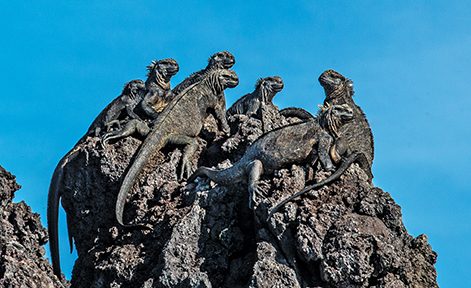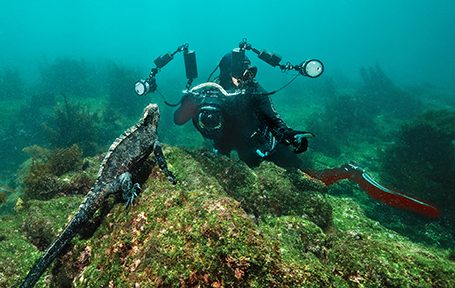IT IS DAY FIVE OF THE VOYAGE, and our liveaboard has finally finished the overnight crossing south from the warm waters of Darwin and Wolf islands to Cape Douglas, Isla Fernandina. Although we don’t travel a great distance on the journey, we cross the equator and move from summer to winter, where prevailing ocean currents plunge the water temperature 18°F (10°C) cooler at our destination. Fernandina seems like half an ocean away in terms of the temperature change, a common conundrum when traveling between islands in the Galápagos archipelago.
At Fernandina, our first dive of the morning in 65 feet (19.8 meters) of water is an opening act for the main event, which we have scheduled to begin promptly at noon. But for this one, our divers don extra layers of neoprene to ward off the chill; we expect the water temperature at the bottom to be 64°F (18°C), a considerable change from the balmy 82°F (28°C) we experienced at Wolf and Darwin. This thermal difference exemplifies the influence that several currents exert on the Galápagos. This confluence is a significant reason for many of its unique attributes, including the iconic creature of our pending date.
There is a reason our main event will not occur until noon. Our cold-blooded photographic subject requires a period of warming in the sun to enable feeding for a short window of time in the cold surf.
Like our highly anticipated subjects, I choose to sit out the morning dive, preferring to expend my core warmth on the main event. My dive buddy, Richard Condlyffe, agrees, so we sit on the boat’s top deck, nursing warm cups of tea in the cool air as the rest of the team loads into the rigid inflatable boat (RIB) in full kit for the morning dive.
The weather is nearly perfect. There is only a small ocean swell, but the sea is smooth at our mooring about half a mile offshore. A clear sky adds to our good fortune. The lack of clouds will ensure that our photo subjects receive plenty of warm sunlight, enabling maximum feeding time in the water. Here at Fernandina, we are at the right place at the right time to photograph and video the iconic Galápagos marine iguanas during their feeding period.
Richard and I finish our tea and move below deck to prepare our kits as the rest of the boat completes the morning dive.

There are 11 subspecies of Galápagos marine iguanas, and they typically range between 1 foot and 5 feet long.
A LONG HISTORY
Before Charles Darwin’s historic visit in 1835, the Galápagos Islands were known to sailors as a place to resupply food and water, but his influential On the Origin of Species sparked international curiosity regarding the archipelago’s unique flora and fauna. The odd marine iguana was one of many species Darwin highlighted in his writings.
In 1825 zoologist Thomas Bell first classified Amblyrhynchus cristatus, the Galápagos marine iguana. These unique reptiles forage on intertidal and subtidal algae in the relatively cool waters around the islands, which are usually between the mid-60s˚F and 80s°F (17°C and 27°C). As cold-blooded reptiles with a preferred body temperature between 95°F and 99°F (35°C and 37°C), they have evolved a thermoregulation behavior that allows them to graze on the species of red and green algae found in a cold sea, which adds to their uniqueness in the animal kingdom.
Scientists believe that the ancestor to the marine iguana found its way to the Galápagos by hitching a ride on rafts of vegetation from mainland South America, likely millions of years ago. These rafts and their hitchhikers eventually drifted on currents to the remote, uninhabited islands. With few predators and abundant food, the iguana had the time and resources to adapt — and it did precisely that.

The black volcanic rocks on the islands are the perfect spot for marine iguanas to sunbathe and warm themselves.

Richard Condlyffe photographs an obliging iguana.
Early visitors to the Galápagos Islands apparently considered the marine iguana ugly and disgusting. In 1798 Capt. James Colnett of the British Royal Navy described them in his journals as “small, and of a sooty black, which, if possible, heightens their native ugliness. Indeed, so disgusting is their appearance, that no one on board could be prevailed upon to take them as food.”
They initially repulsed even Darwin. In the Sept. 17, 1835, entry of Charles Darwin’s Beagle Diary, he wrote, “The black Lava rocks on the beach are frequented by large (2–3 ft) most disgusting, clumsy Lizards. They are as black as the porous rocks over which they crawl & seek their prey from the Sea. – Somebody calls them ‘imps of darkness.’ – They assuredly well become the land they inhabit.” It’s perhaps fortunate that the early visitors to the Galápagos found the reptile unpleasant, and these docile creatures with such environmentally specific needs were left alone to flourish.
Scientists have now classified 11 subspecies, each unique to the islands they inhabit. Marine iguanas usually range from 1 foot to 5 feet (0.3 to 1.5 meters) in length. Typically, the larger the island, the larger the subspecies, with the iguanas on Isabela and Fernandina being the largest. Whether you think of them as one of nature’s unique sculptures or as miniature Godzillas, these fantastic animals top the list for shooters venturing to the Galápagos Islands. Indeed, beauty is in the eye of the beholder.
Sunlit Sightings
Finally, it’s time for the main event. Richard and I made a good choice when we wagered that sitting out the morning dive would maximize our comfort for the afternoon; several divers still feel chilled.
We depart on the RIB at high noon and motor just off the rocky beach. The shore here is a mixture of the white sand necessary for laying eggs during the nesting season and the black volcanic rock that helps the iguanas warm quickly. Conditions are nearly perfect, so our divemasters have given each pair of divers their own expansive section of surf just beyond the small breakers. Richard and I have a parcel in a natural cove that stairsteps quickly from 3 feet down to 16 feet (0.9 to 4.9 meters).
The sun has been hot, and as if on cue with our arrival, there are suddenly dozens of black shapes bobbing on the surface all around the RIB. The iguanas are already in the surf! We make a final gear check before rolling back into the 64°F (18°C) water. With no breeze, it’s hot above the surface, and like our dark-skinned lizard friends, we welcome the cool water.
The shallow cove is beautiful, with red, green, and brown algae shimmering in the bright sunlight. I immediately find a 3-foot (0.9-meter) iguana munching algae off a rock as I settle to the bottom at 10 feet (3 meters). With a quick check all around me, I see two more large reptiles within the 26 feet (7.9 meters) of visibility and realize it won’t be hard to find subjects.
I turn to point out the lizards to Richard, but he is already shooting subjects of his own. There are lizards everywhere: on the bottom, on the surface, and some slowly snaking their way upward.
While easy to approach and ambivalent about presence, they are somewhat tricky subjects to shoot in bright conditions. Getting detail in my images in the high-contrast environment takes some work. Strobes help, but the abundant plankton and particulate matter in the water column result in extensive backscatter. I constantly adjust my strobe angles and power settings, checking my histograms and images in the camera’s viewfinder, looking for the perfect shot.
With just a precious hour to visit these remarkable animals, I cover the cove several times over, shooting video and still images with and without Richard as a secondary subject. And then, as quickly as it began, it was time to return to the boat and leave our subjects to the damselfish and sea lions that share their realm.
In a world of dive experiences spanning many decades, it can be increasingly difficult to find somewhere that inspires childlike wonder. Fortunately, the Galápagos is one of those places. The captivating landscape and extraordinary animals make it easy to imagine you are experiencing it much as Darwin did or perhaps as if you are the first human visitor.
My trip to the Galápagos was astonishing, but the dive with the marine iguanas was beyond so. It was a magical experience that gave me the elusive excitement of discovery, if only for an hour. AD
© Alert Diver — Q2 2022